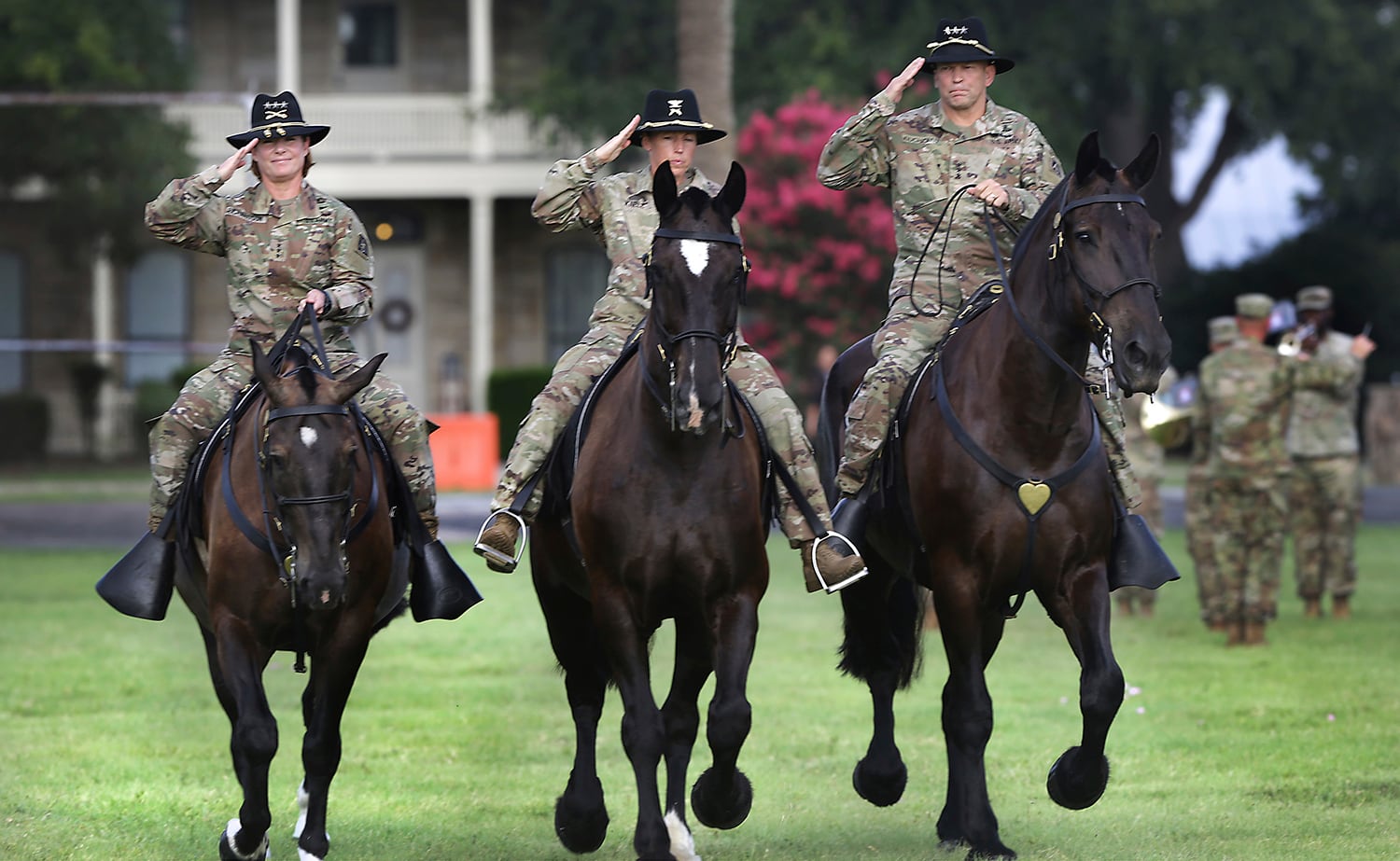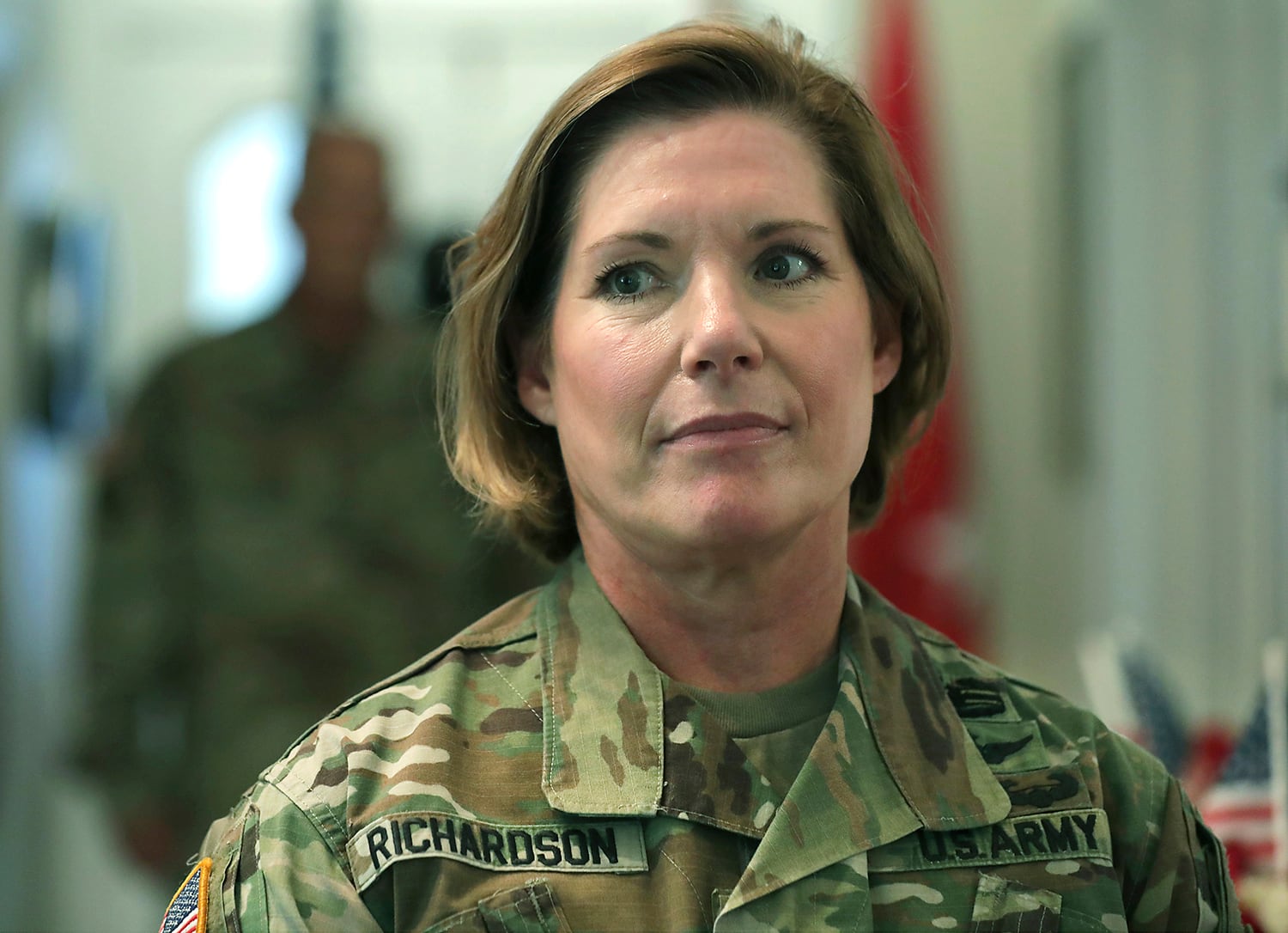SAN ANTONIO — As Lt. Gen. Laura J. Richardson took command of U.S. Army North on Monday morning before hundreds of dignitaries, she took stock of a life unbarred by barriers.
The kind of barriers that women have faced.
The San Antonio Express-News reports a champion swimmer at 8, private aviator at 15, All-American swimmer in college and UH-60 Black Hawk helicopter pilot who flew combat missions in 2003, the first year of the Iraq War, she grew up competitive, an athlete whose mom and dad literally let her spread her wings — without artificial limits.
"I'm the daughter of great parents who always told me I could do anything and never put the typical gender norms on me," she told the crowd. "In fact, as the oldest of four kids, I think my dad thought I was his son for the first 10 years on earth."
Richardson, 55, spoke briefly after taking command from Lt. Gen. Jeffrey Buchanan, who is retiring after three years here. After a 15-round cannon salute, and with the 323rd Army Band performing songs from the divisions in which he served over a 37-year career, Buchanan and Richardson mounted horses and rode slowly, "trooping the line" of 200 soldiers standing at attention on Staff Post Field near the historic Quadrangle at Joint Base San Antonio-Fort Sam Houston, where she'll work.
They then stood before their boss, Gen. Terrence J. O’Shaughnessy, as Richardson accepted Army North’s flag to symbolize the transfer of command. O’Shaughnessy leads U.S. Northern Command, or NORTHCOM, created in 2002 to run the Pentagon homeland defense efforts and coordinate support of civil authorities.
Richardson, already the Army’s first female combat arms general officer, became its first woman to command the Army component of a larger, multiservice unit.
Standing in a crowd that included four former Army North commanders — all retired three-star generals — was Richardson's husband, Lt. Gen. James "Jim" Richardson. Called "dual military" couples, they're somewhat common at lower ranks across the armed services, but the Richardsons are the only married three-star generals in the Army.
It's a difficult lifestyle. Dual military families often are separated as they work at installations around the United States and overseas, including war zones. In her brief address to a crowd of more than 500 sitting in bleachers and under tents, Laura Richardson made a point of thanking her family for having her back over the years.
"I am here today because of my family and the great soldiers I have had the honor to serve with. I want to thank my husband, Jim, and my daughter, Lauren, for their support, encouragement and patience over my 32 years in the Army. Without that support we would not have been able to sustain a dual military family for 31 years, and I am very grateful, and I love you," she said.
In an interview, Richardson didn’t want to go into specifics about the number of years she and her husband have lived apart. In their most recent assignments, she was deputy commanding general at U.S. Army Forces Command in Fort Bragg, North Carolina, while he was confirmed by the Senate last September as deputy commander of the Army Futures Command in Austin after working in the Pentagon and as deputy commanding general of III Corps at Fort Hood.
The distance won't be great these days. Jim Richardson, an AH-64D Apache helicopter pilot with 4,300 hours in the air — 2,000 of them in combat — and seven tours of Iraq and Afghanistan, is just up the road and can make weekend visits to her spacious, century-old home at Fort Sam.
Laura Richardson is one of four female three-star generals in the Army. The others are Gwendolyn Bingham, assistant chief of staff for installation management in Washington; Nadja West, Army surgeon general and commander of the U.S. Army Medical Command in Falls Church, Virginia; and Karen Gibson, deputy director of national intelligence for national security partnerships, office of the director of national intelligence in Washington.
There have been no women four-stars since Gen. Ann Dunwoody retired in 2012, Army spokesman William Sharp said.

Army North, with 600-plus service members and 330 civilians, provides command and control of subordinate units and joint interagency and military partners in Mexico and Canada. The command has been busy under Buchanan, supporting the Homeland Security Department on the Southwestern border and helping the Federal Emergency Management Agency after Hurricanes Matthew, Harvey, Irma, Maria, Florence and Michael.
"I come from an Army family," said Buchanan, 59, who served four tours in Iraq and one in Afghanistan. "My mother was the wife of a soldier and a mother of a soldier. My bride, Laura, was the daughter of a soldier, the wife of a soldier and the mother of a soldier. Our oldest grandchild, Piper, is in attendance here today, and both of her grandpas are here, and both are soldiers. We're an Army family, and I'm proud to be a soldier. More importantly, I will always be a soldier."
Laura Richardson's story as a soldier is similar to high-ranking women in the Air Force, who have said they lacked female mentors as they've moved into greater responsibility. In Richardson's case, every boss she's ever had since graduating from Metropolitan State College in Denver as a second lieutenant was a man.
She waved off the suggestion that such an experience caused her problems. Being a woman in a male-dominated Army hasn't been difficult, Richardson said. It was important to be treated "just like anybody else," she said.
"I wouldn't be where I am today if I had folks that were easier or harder on me," Richardson said. "The great leaders I've had as bosses have all been men. I haven't worked for one woman. In fact, there were a lot of times, even now, these days, but even back as I was . going up through the Army, all the sudden I'd go, 'Wow, I'm the only gal sitting here in the room.' But it wasn't something that I noticed unless I took notice."
Growing up as an athlete might have had something to do with it.
“You had to do what you had to do to be competitive against your counterparts,” Richardson said. “I could run faster than them, I could do more pushups in PT than them, I could fly better than them in flight school, and when I got asked questions, I knew my academics, and so that’s how you take what the environment is to be competitive and then you go do it.”




